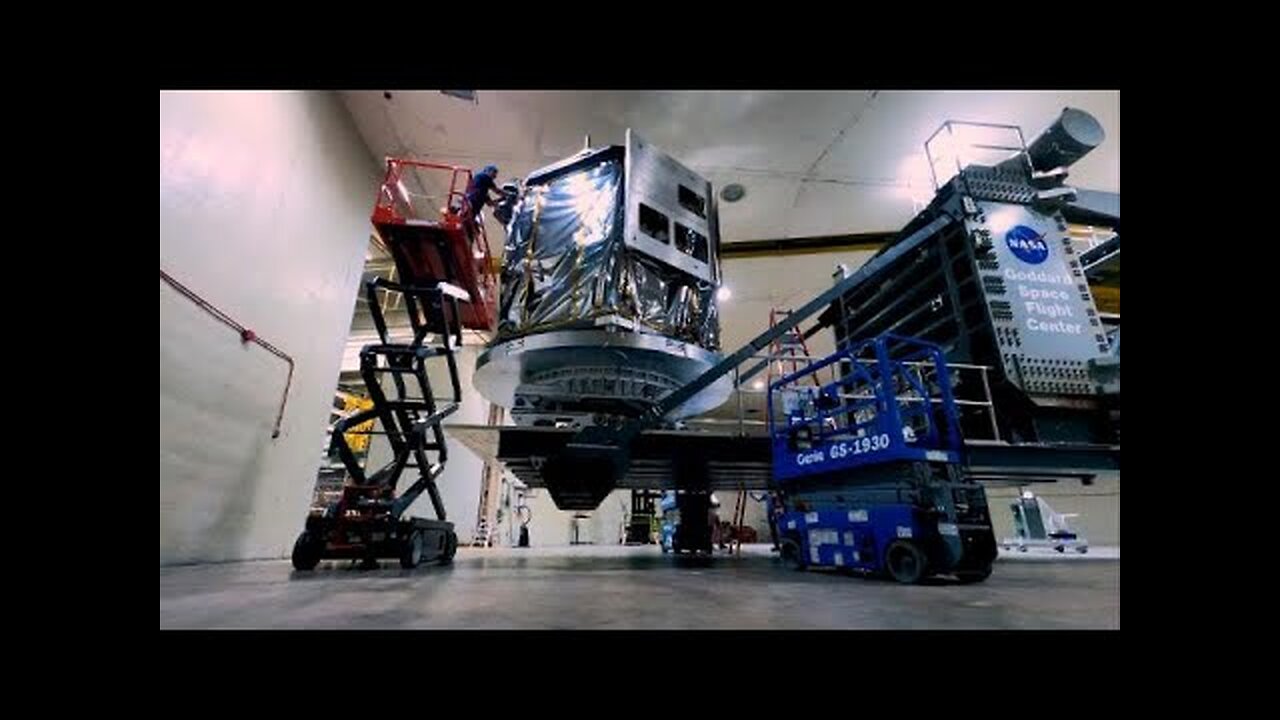Premium Only Content

Roman Space Telescope: Full Outer Barrel Assembly Testing Time-lapse
The Outer Barrel Assembly, or OBA, is a key part of the Nancy Grace Roman Space Telescope. It is made of two main parts: the shell section, a baffled carbon-fiber tube that surrounds the telescope to keep the temperature stable and project it from stray light; and the support struts, which extend past the instruments to connect the shell section to the rear spacecraft bus where all the support systems are located. Although the OBA is one of the less complicated parts of the overall observatory, the testing process for it is anything but simple. This time-lapse covers one tiny part of the intricate dance that all of Roman’s systems have been working their way through on their path to joining together as the complete observatory.
Just one of the many tests the OBA undergoes is static load testing in NASA’s Goddard Space Flight Center’s 120-foot-diameter centrifuge. The two parts of the OBA are separated and tested individually, with aluminum weights called mass simulators, or mass sims for short, taking the place of other parts of the spacecraft and creating the correct center of gravity. Nearly 100 sensors are connected throughout the structure to carefully measure the strain on each part of it. The OBA is attached to a metal plate which can tip and rotate hydraulically to change the position of the test hardware. These changes in position ensure that every component of the hardware experiences the full launch load.
The struts are tested in six different orientations first. Tilting for the sixth, and final test, is where this time-lapse begins. After the final test, the multi-day process of removing the struts and replacing them with the shell section begins. All of the mass sims and sensors need to come off of the struts, while, at the same time, different mass sims are added to the shell section, which is in a separate clean room. The shell section is also wrapped in protective Kapton film to reduce contamination in the non-clean environment of the centrifuge.
The struts are topped with a metal interface ring that connects them and gives structural stability. This same ring is needed to connect the shell section to the adjustable test platform and so it must be transferred from the struts to the shell. The simplest way to do this is to connect the two pieces in, with the interface ring between them, in an adjoining “high-bay” with plenty of vertical room and floor space for the two pieces to sit side-by-side on dollies. The complete OBA is then hand-pushed into the centrifuge, to a different crane, and the shell section is lifted off with the interface ring now attached only to it. The struts are pushed out and taken to the next testing step.
The OBA is attached to the centrifuge test platform and has 96 sensors carefully connected at key locations. Like the struts, it will have six spins of different intensities and positions, culminating in a final spin at 18.4 rpm and 7.1 Gs. At that speed, the wind around the edges of the centrifuge travels at 80 miles per hour, and at over 130 mph along the ground.
Music Credit: “Concave Hexagon", "Convex Pentagon", "Dodecahedron", "Equilateral Triangle", "Heptagon", "Irregular Quadrilateral", "Kite", "Square-based Pyramid", "Icosahedron” from the album Geometric Shapes. Written and produced by Lars Leonhard.
Credit: NASA’s Goddard Space Flight Center
-
 LIVE
LIVE
Fresh and Fit
5 hours agoMyron TRIGGERED Rubi Rose Over This!
6,581 watching -
 LIVE
LIVE
TheSaf3Hav3n
3 hours ago $3.04 earnedCALL OF DUTY: BLACK OPS 6 | A QUIET PLACE: THE ROAD AHEAD | #RumbleTakeOver
931 watching -
 LIVE
LIVE
TheNateVibez
3 hours agoOmni-🤖 - First Rumble Stream.🫡 - VETERAN
1,459 watching -
 LIVE
LIVE
Tundra Gaming Live
7 hours ago $1.92 earnedThe Worlds Okayest War Thunder Stream//FORMER F-16 MAINTAINER//77th FS//#rumblefam
159 watching -
 2:32:19
2:32:19
DemolitionDx
3 hours agoSunday night COD with friends.
29.6K1 -
 2:10:14
2:10:14
vivafrei
13 hours agoEp. 237: More Trump Cabinet Picks! MAHA or Slap in the Face? Canada on Fire! Go Woke Go Broke & MORE
171K214 -
 2:23:21
2:23:21
SOLTEKGG
3 hours ago $2.80 earned🟢 First Day on RUMBLE!
30.2K3 -
 LIVE
LIVE
Vigilant News Network
7 hours agoCOVID-Vaccinated Hit With Grave New Reality | Media Blackout
2,108 watching -
 1:26:31
1:26:31
Josh Pate's College Football Show
7 hours ago $2.20 earnedSEC Disaster Saturday | Major CFP Earthquake Coming | Officiating Is A Disaster | New Studio Debut
21.4K1 -
 1:43:05
1:43:05
Adam Does Movies
10 hours ago $3.93 earnedGladiator II Spoiler Conversation With Hack The Movies
24K1